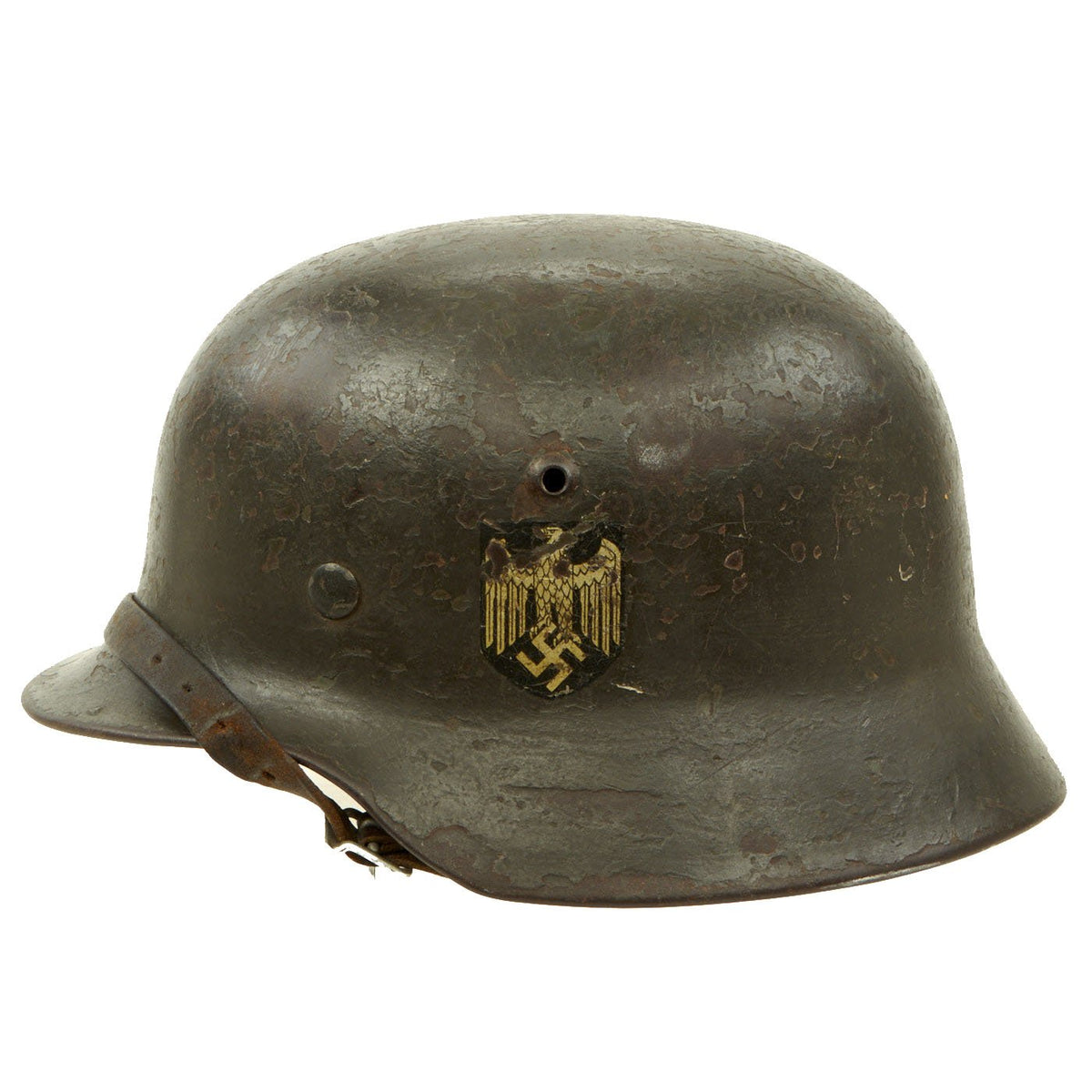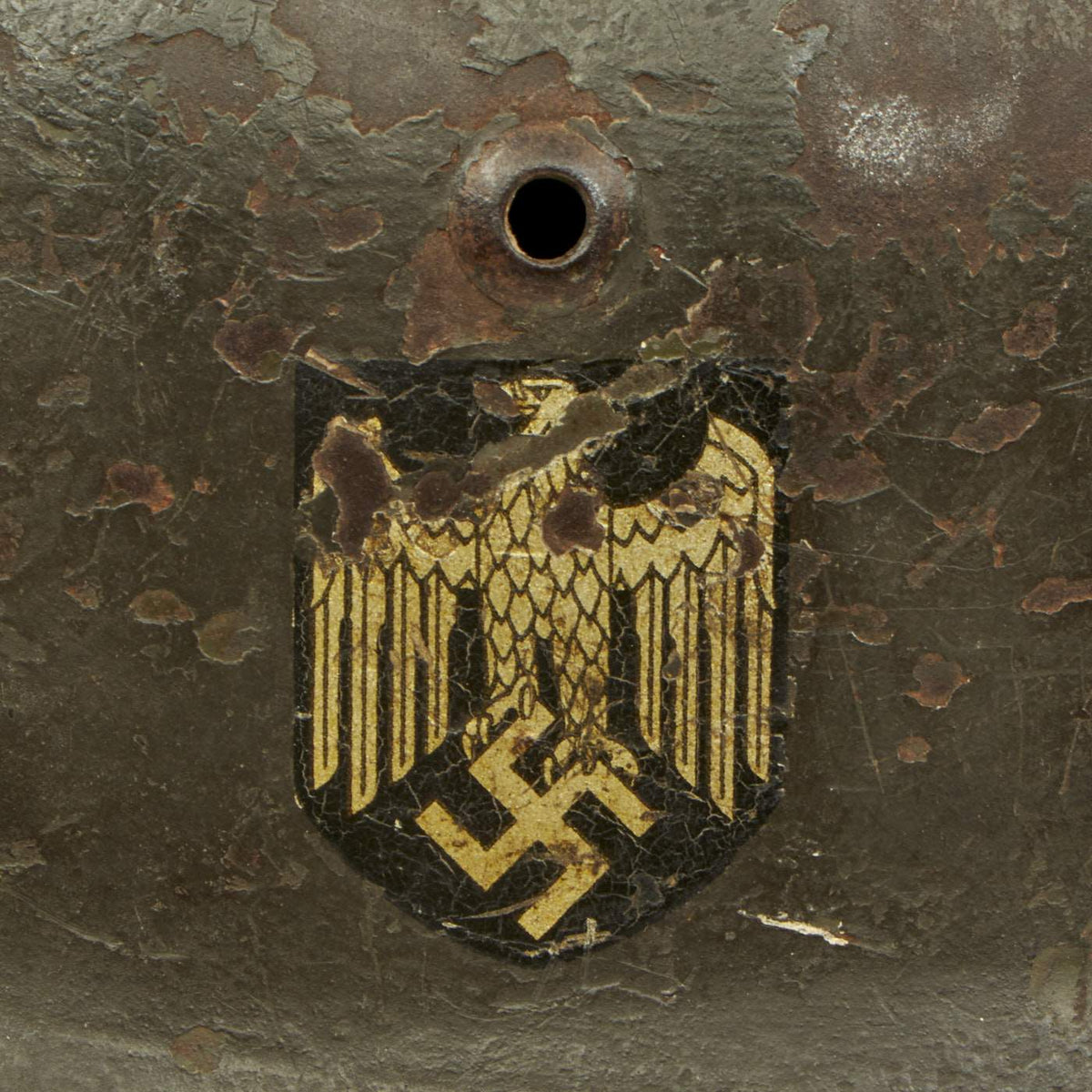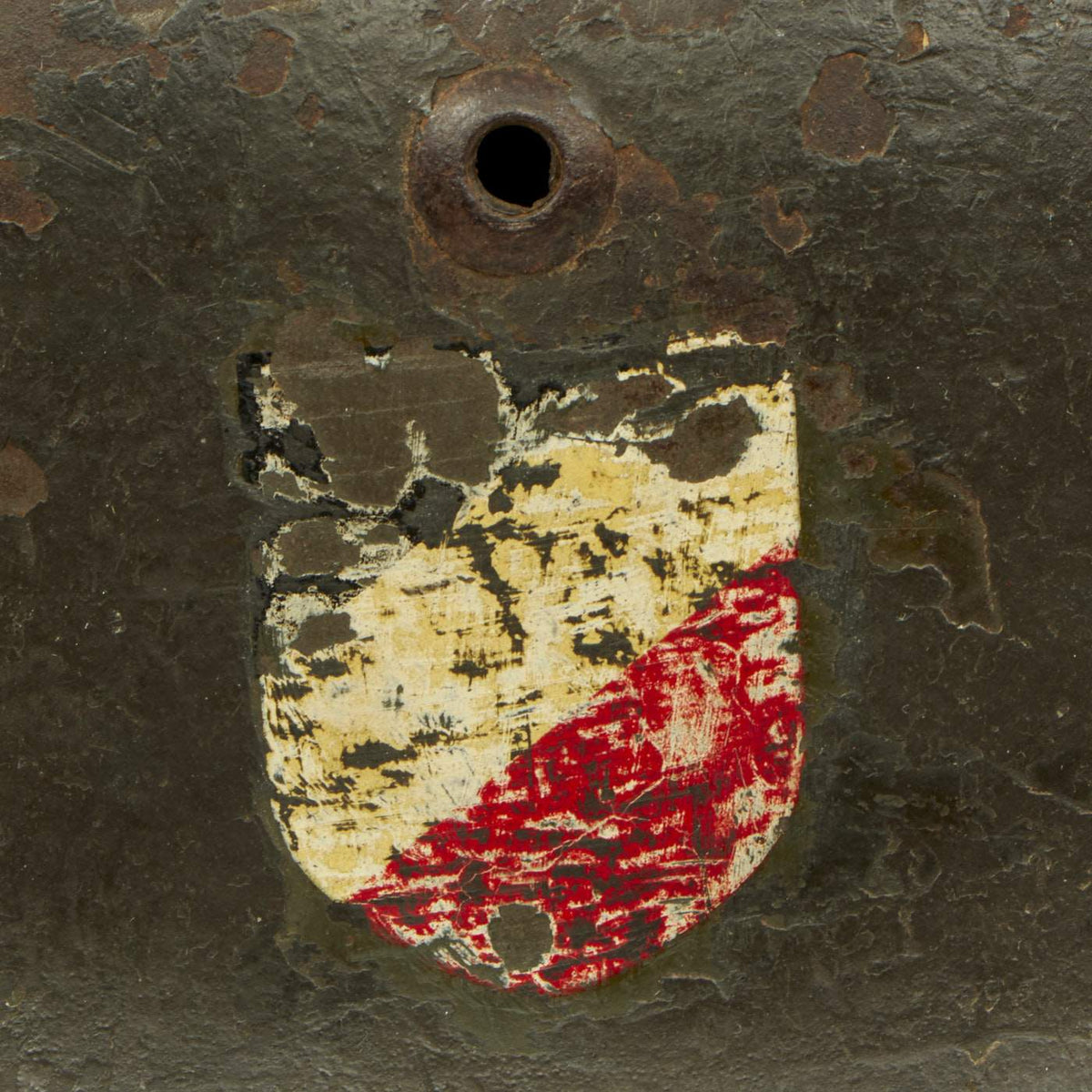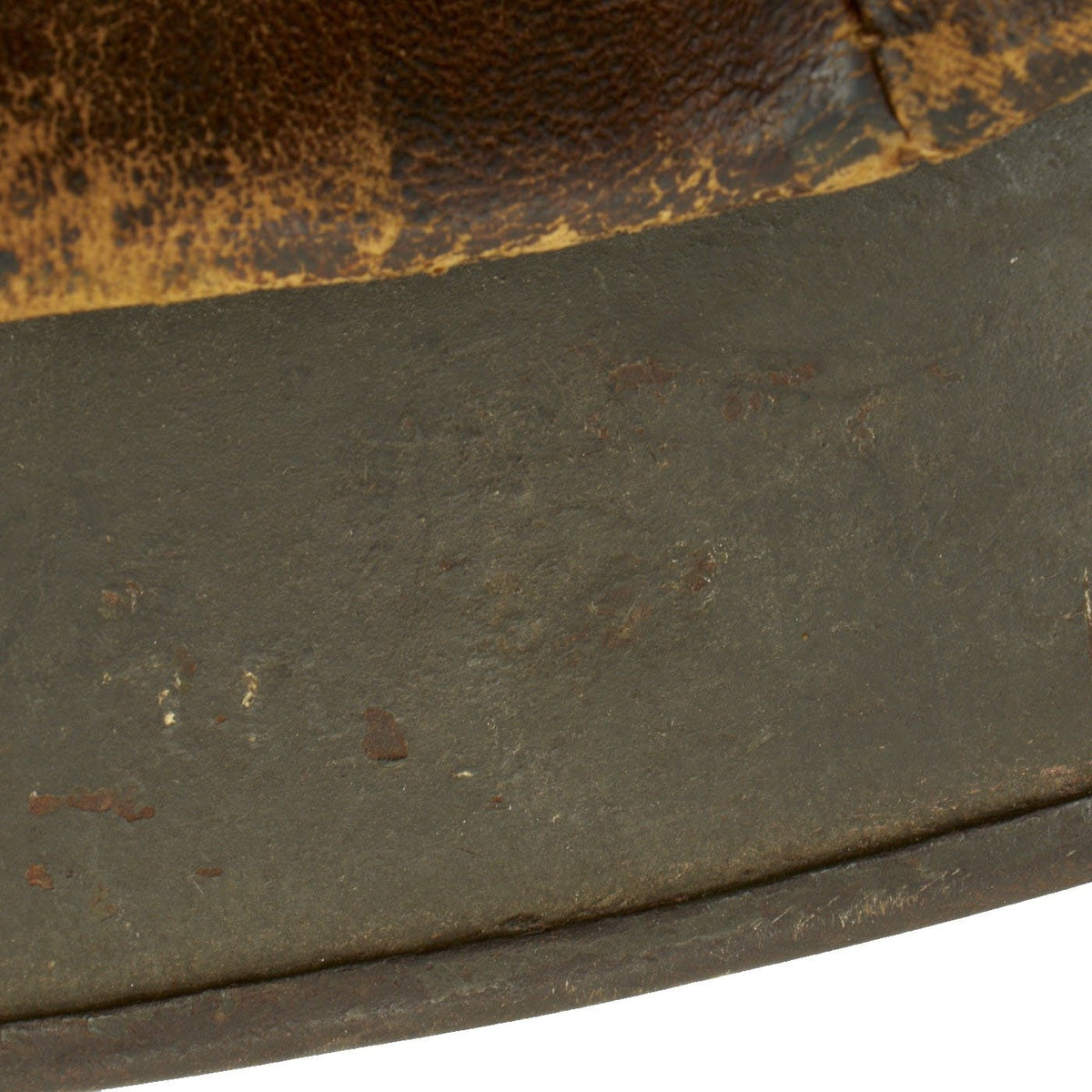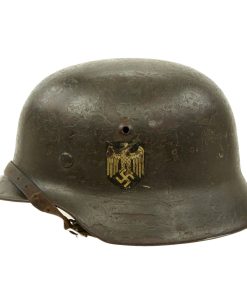Original German WWII Army Heer M35 Double Decal Helmet with 1939 Dated Size 56cm Liner – SE64 Original Items
$ 2.195,00 $ 548,75
Original Item: Only One Available. This is an incredible service worn condition all original example of a German WWII M35 helmet, as issued to the Heer (Army) . This stamped sheet steel construction helmet retains about 50% of its original paint, and definitely shows service wear. It is painted in a very nice mid war Feldgrau (field gray) paint, but looks to have originally been the lighter Apfel-grün (apple green), and was repainted during the war.
The use of the second decal was discontinued in 1940, and in 1943 it was ordered that helmets with the national colors have them removed. The decal on this helmet however escaped that fate, so it still has both decals. The left side of the helmet features a Heer eagle decal, which is retained about 85%, which is partially chipped away, but still has great colors. The right side of the helmet features a national colors decal, which is retained about 75%, but has quite a bit of wear from being cleaned off after it was repainted. Definitely lots of history here!
The reverse, interior, neck guard apron is serial number stamped 3168 (somewhat unclear) and the interior, left side, apron has the stamped manufacturer’s code and size, SE64 indicating that it was manufactured by Sächsische Emaillier und Stanzwerke A.G. of Lauter, Germany. Size 64 is a nice medium size that can accommodate liners from 56cm to 57cm or US 7 to 7 1/8. Size 64 shells are harder to find and are therefore more valuable to a collector. At the back of the apron there also looks to be painted marking “O Kan”, however this was painted over and can only be seen by holding the helmet in the light to see a reflection.
All three liner retaining pins are intact, and all still have most of the original paint present. The interior of the helmet still has the original M31 leather liner with all eight of its fingers intact, with the original top tie. The leather is still quite soft, with no tearing, though it is now quite dark in color, almost looking like it was dyed. There is some wear and tearing around the edges, which is very common. The liner band is aluminum, with square aluminum chin strap loops attached to reinforced sides. This is the last pattern before the move to galvanized steel bands. The left exterior of the liner band is marked 64 n.A / 56, indicating that it is a size 56 liner for a size 64 shell. It is also maker marked and dated on the other side:
SCHUBERTH – WERK K.-G.
D.R.P.
1939
BRAUNSCHWEIG
Attached to the liner is an original chin strap, with the correct aluminum studs and buckle found on early issue chin straps. There is a faded marking on the long end, however we can no longer read it. The chin strap does show wear and stretching, but there is no tearing and it is still mostly soft.
Overall a very nice 100% genuine M35 Double Decal Heer Army helmet with loads of history! It looks great, and all components are correct! This is an item that will only continue to appreciate in value over time!
The first “modern” steel helmets were introduced by the French army in early 1915 and were shortly followed by the British army later that year. With plans on the drawing board, experimental helmets in the field, (“Gaede” helmet), and some captured French and British helmets the German army began tests for their own steel helmet at the Kummersdorf Proving Grounds in November, and in the field in December 1915. An acceptable pattern was developed and approved and production began at Eisen-und Hüttenwerke, AG Thale/Harz, (Iron and Foundry Works), in the spring of 1916.
These first modern M16 helmets evolved into the M18 helmets by the end of WWI. The M16 and M18 helmets remained in usage through-out the Weimar Reichswehr, (National Defence Force, Circa 1919-1933), era and on into the early years of the Third Reich until the development of the smaller, lighter M35 style helmet in June 1935.
In 1934 tests began on an improved Stahlhelm, whose design was a development of World War I models. The Eisenhüttenwerke company of Thale carried out prototype design and testing, with Dr. Friedrich Schwerd once again taking a hand.
The new helmet was pressed from sheets of molybdenum steel in several stages. The size of the flared visor and skirt was reduced, and the large projecting lugs for the obsolete armor shield were eliminated. The ventilator holes were retained, but were set in smaller hollow rivets mounted to the helmet’s shell. The edges of the shell were rolled over, creating a smooth edge along the helmet. Finally, a completely new leather suspension, or liner, was incorporated that greatly improved the helmet’s safety, adjustability, and comfort for each wearer. These improvements made the new M1935 helmet lighter, more compact, and more comfortable to wear than the previous designs.
The Army’s Supreme Command officially accepted the new helmet on June 25, 1935 and it was intended to replace all other helmets in service.
More than 1 million M1935 helmets were manufactured in the first two years after its introduction, and millions more were produced until 1940 when the basic design and production methods were changed.
Fast Shipping with Professional Packaging
Thanks to our longstanding association with UPS FedEx DHL, and other major international carriers, we are able to provide a range of shipping options. Our warehouse staff is expertly trained and will wrap your products according to our exact and precise specifications. Prior to shipping, your goods will be thoroughly examined and securely secured. We ship to thousands clients each day across multiple countries. This shows how we're dedicated to be the largest retailer on the internet. Warehouses and distribution centres can be located throughout Europe as well as the USA.
Note: Orders with more than one item will be assigned a processing date depending on the item.
Before shipping before shipping, we'll conduct a thorough inspection of the items you have ordered. Today, the majority of orders will be delivered within 48 hours. The delivery time will be between 3-7 days.
Returns
The stock is dynamic and we cannot completely manage it because multiple stakeholders are involved, including our factory and warehouse. So the actual stock may alter at any time. It's possible that you may not receive your order once the order has been made.
Our policy is valid for a period of 30 days. If you don't receive the product within 30 days, we are not able to issue a refund or an exchange.
You can only return an item if it is unused and in the same state as the day you received it. You must have the item in its original packaging.
Related products
Uncategorized
Uncategorized
Uncategorized
Angolan Rebel 1970s era 60mm Inert Display Mortar from Angolan Civil War Original Items
Uncategorized
Uncategorized
Uncategorized
Uncategorized
Uncategorized
Uncategorized
Uncategorized
Uncategorized
Uncategorized
Uncategorized
Uncategorized
Uncategorized
